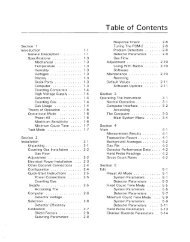Medical Physics Hand.. - Voss Associates
Medical Physics Hand.. - Voss Associates
Medical Physics Hand.. - Voss Associates
You also want an ePaper? Increase the reach of your titles
YUMPU automatically turns print PDFs into web optimized ePapers that Google loves.
Positron Emitters Beta+ Energy and % AbundanceHalf-life MeV (%)C-11 20.3 m 0.960 (99.8%)N-13 9.97 m 1.199 (99.8%)O-15 122 s 1.732 (99.9%)F-18 1.83 h 0.634 (96.7%)Na-22 2.605 y 0.546 (89.8%)Al-26 7.3E5 y 3.210 (100%)V-48 15.98 d 0.697 (50.1%)Mn-52 5.591 d 2.633 (94.9%)Co-56 77.3 d 1.458 (19.0%)Ni-57 35.6 h 0.737 (7.0%), 0.865 (35.3%)Co-58 70.88 d 0.475 (14.9%)Cu-62 9.74 m 2.926 (97.2%)Zn-65 243.8 d 0.330 (1.4%)Ga-68 67.7 m 0.822 (1.2%), 1.899 (89.1%)As-74 17.8 d 0.945 (26.1%), 1.540 (3.0%)Rb-82 1.26 m 2.601 (13.1%), 3.378 (81.8%)Several of the positron emitters are useful in PET studies.That usefulness is somewhat offset by the cost of producingthe radionuclides and the added complexity of radiationprotection. For all of the positron emitters the energy of theBeta+ must be considered. Refer to the table of Beta DoseRates for estimates of beta+ radiation exposure. Also,consider the annihilation photons when the positron comesinto contact with a beta-, annihilating their masses andproducing two 511 KeV photons. These photons present anexternal radiation hazard. For the patient undergoing a PETscan the combination of the positron energy and the photonenergy must be considered.33Positron Emitters Beta+ Energy and % AbundanceHalf-life MeV (%)C-11 20.3 m 0.960 (99.8%)N-13 9.97 m 1.199 (99.8%)O-15 122 s 1.732 (99.9%)F-18 1.83 h 0.634 (96.7%)Na-22 2.605 y 0.546 (89.8%)Al-26 7.3E5 y 3.210 (100%)V-48 15.98 d 0.697 (50.1%)Mn-52 5.591 d 2.633 (94.9%)Co-56 77.3 d 1.458 (19.0%)Ni-57 35.6 h 0.737 (7.0%), 0.865 (35.3%)Co-58 70.88 d 0.475 (14.9%)Cu-62 9.74 m 2.926 (97.2%)Zn-65 243.8 d 0.330 (1.4%)Ga-68 67.7 m 0.822 (1.2%), 1.899 (89.1%)As-74 17.8 d 0.945 (26.1%), 1.540 (3.0%)Rb-82 1.26 m 2.601 (13.1%), 3.378 (81.8%)Several of the positron emitters are useful in PET studies.That usefulness is somewhat offset by the cost of producingthe radionuclides and the added complexity of radiationprotection. For all of the positron emitters the energy of theBeta+ must be considered. Refer to the table of Beta DoseRates for estimates of beta+ radiation exposure. Also,consider the annihilation photons when the positron comesinto contact with a beta-, annihilating their masses andproducing two 511 KeV photons. These photons present anexternal radiation hazard. For the patient undergoing a PETscan the combination of the positron energy and the photonenergy must be considered.33Positron Emitters Beta+ Energy and % AbundanceHalf-life MeV (%)C-11 20.3 m 0.960 (99.8%)N-13 9.97 m 1.199 (99.8%)O-15 122 s 1.732 (99.9%)F-18 1.83 h 0.634 (96.7%)Na-22 2.605 y 0.546 (89.8%)Al-26 7.3E5 y 3.210 (100%)V-48 15.98 d 0.697 (50.1%)Mn-52 5.591 d 2.633 (94.9%)Co-56 77.3 d 1.458 (19.0%)Ni-57 35.6 h 0.737 (7.0%), 0.865 (35.3%)Co-58 70.88 d 0.475 (14.9%)Cu-62 9.74 m 2.926 (97.2%)Zn-65 243.8 d 0.330 (1.4%)Ga-68 67.7 m 0.822 (1.2%), 1.899 (89.1%)As-74 17.8 d 0.945 (26.1%), 1.540 (3.0%)Rb-82 1.26 m 2.601 (13.1%), 3.378 (81.8%)Several of the positron emitters are useful in PET studies.That usefulness is somewhat offset by the cost of producingthe radionuclides and the added complexity of radiationprotection. For all of the positron emitters the energy of theBeta+ must be considered. Refer to the table of Beta DoseRates for estimates of beta+ radiation exposure. Also,consider the annihilation photons when the positron comesinto contact with a beta-, annihilating their masses andproducing two 511 KeV photons. These photons present anexternal radiation hazard. For the patient undergoing a PETscan the combination of the positron energy and the photonenergy must be considered.33Positron Emitters Beta+ Energy and % AbundanceHalf-life MeV (%)C-11 20.3 m 0.960 (99.8%)N-13 9.97 m 1.199 (99.8%)O-15 122 s 1.732 (99.9%)F-18 1.83 h 0.634 (96.7%)Na-22 2.605 y 0.546 (89.8%)Al-26 7.3E5 y 3.210 (100%)V-48 15.98 d 0.697 (50.1%)Mn-52 5.591 d 2.633 (94.9%)Co-56 77.3 d 1.458 (19.0%)Ni-57 35.6 h 0.737 (7.0%), 0.865 (35.3%)Co-58 70.88 d 0.475 (14.9%)Cu-62 9.74 m 2.926 (97.2%)Zn-65 243.8 d 0.330 (1.4%)Ga-68 67.7 m 0.822 (1.2%), 1.899 (89.1%)As-74 17.8 d 0.945 (26.1%), 1.540 (3.0%)Rb-82 1.26 m 2.601 (13.1%), 3.378 (81.8%)Several of the positron emitters are useful in PET studies.That usefulness is somewhat offset by the cost of producingthe radionuclides and the added complexity of radiationprotection. For all of the positron emitters the energy of theBeta+ must be considered. Refer to the table of Beta DoseRates for estimates of beta+ radiation exposure. Also,consider the annihilation photons when the positron comesinto contact with a beta-, annihilating their masses andproducing two 511 KeV photons. These photons present anexternal radiation hazard. For the patient undergoing a PETscan the combination of the positron energy and the photonenergy must be considered.33













